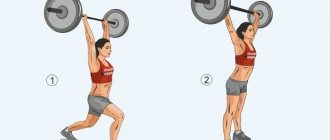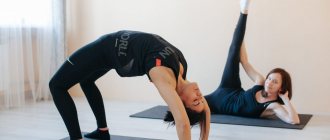Find your love
I train three times a week and only skip training if I'm really really sick.
Even when I broke the little finger on my right hand, I continued to go to the gym: I did pull-ups with a barbell strap and did burpees on one arm (it was tough!). I’m not a professional athlete, I don’t prepare for competitions and I never force myself to go to the gym because “it’s necessary.” I just love CrossFit so much that I’m happy to come to training. This doesn't mean that CrossFit is so good that it will necessarily make you fall in love with the sport. On the contrary, it will terrify many.
Try as many sports as possible until you find yours. Don't stop - it definitely exists.
Before finding CrossFit, I tried dancing, running, karate, yoga, swimming, cycling, rock climbing, and strength training at the gym. There was something attractive everywhere, but in the end it became boring. So if you've only tried running or strength training and are underwhelmed, keep looking.
What to do next
You have realized what exactly you want to get from regular exercise. No one puts moral pressure on you. You are ready to take action.
Find your sport
The first thing to do is to find a sport that will inspire you to continue practicing. Try different sports activities that suit your internal needs and preferences, and most importantly, your physical health. Sport should not cripple. Therefore, before starting classes, go for a medical examination and find out if you have any disorders that may be a contraindication to this or that type of physical activity.
Guys for the most part prefer strength training to pump up muscles and make their body more sculpted. For a person who accumulates a lot of aggressive energy during the day, it is best to throw it out in boxing and hand-to-hand combat classes. Those who like to think about philosophical topics can try themselves in martial arts.
For fans of less intense activities, aerobic training is suitable:
- yoga;
- Pilates;
- callanetics;
- stretching
Women who want to not only have a toned figure, but also learn to move beautifully, will definitely appreciate one of the dance styles:
- half-dance;
- strip of plastic;
- hip-hop;
- salsa;
- twerk;
- Latin American tango.
In general, the choice is huge. To get started, buy a one-time visit to the type of class you like. Did you feel an emotional uplift after your workout? Then purchase a subscription.
You can train in groups or individually.
Group training is good because you will be fueled by common energy. Especially when on the next approach you feel an irresistible desire to give up. Looking at the neighbor on your right or left, stubbornly continuing to do the exercise by the sweat of your brow, you will also find the strength to continue.
Those who are too shy or prefer an individual approach should work with a personal trainer. He will create your personal training plan depending on your level of training and the desired result.
Look for external sources of motivation
Having chosen for yourself the appropriate type of physical activity that matches your goals (losing weight, developing endurance, flexibility, strength, reaction, improving health indicators, correcting the proportions of your figure, etc.), you should start looking for sources of motivation from the outside.
At first, willful efforts will be enough for you. But strength can quickly run out. Then the support of relatives and close friends will help. However, to play sports systematically, you need a powerful source of internal motivation.
You can try to find it on the Internet. There are many bloggers on Instagram who share their achievements with followers. Someone managed to lose weight from 100 to 55 kg, someone learned to do the splits, do 50 pull-ups, 100 push-ups, ran a marathon, etc.
Try to find a person whose example will inspire you to go to the gym not only a couple of times a week, but every day.
If you couldn’t find such a person, then maybe you should become a public figure yourself? Publish your sports goal on your social media account and regularly post photos and posts that will talk about your results and successes. Public opinion is a very strong source of motivation. Even if the audience's interest wanes over time, you will already have developed a habit of sports.
Don't want to post anything on social networks? Then make a bet with your friends to achieve a certain sports result. You don't want to be a loser, do you? By the way, this method is perfect if you don’t know how to get a man to exercise. Just take it “weakly”.
Find a like-minded person
If you find it boring to exercise alone, find a like-minded person to support you. It is advisable that he already has a well-formed training habit. When you want to skip classes and start persuading your “combat” comrade to do the same, he is unlikely to agree, and he will also shame you. Your momentary weakness will be defeated.
Spend money on sports
How can you exchange a sweet dream in a warm bed in the morning for a run through the cold city streets? If you, like me, are not ready for this, then another option is to spend money on buying a treadmill for exercising at home. Exercise machines are not cheap, and the desire to earn back the money spent will be your incentive. Especially when the exercise machine peeks out reproachfully from under the clothes hung on it.
Another option is to purchase a gym membership for a month, six months or a year. Or purchase classes with a personal trainer. And they cost even more. In this case, greed must overcome a sudden attack of laziness. By force of will you will have to get up from the couch and go to training.
Be sure to treat yourself to a nice fit and comfortable workout shoes. Famous sports brands such as Nike, Adidas, Puma are constantly coming up with new technologies, materials, and trendy styles of clothing for sports. You will want to wear these things more often.
Even if you weren't planning on going to work out today, put on your fitness uniform or tracksuit. Look at yourself in the mirror once again. How is she sitting? Do you feel fit and beautiful? Or maybe it’s worth doing a few exercises right now, without changing into your home clothes?
Keep a diary
Be sure to keep a diary. Describe in it your impressions of the training, sensations and well-being after physical activity. And most importantly, record your results in it depending on your goals:
- how many kilometers did you run;
- how many times did you do push-ups?
- how long did you stand in the plank;
- current weight;
- waist, hips, biceps, etc.
You can use a fitness bracelet for the same purposes. It will also help track your progress, and will also remind you about training in advance.
Your before and after workout photos will be a great motivator. Do them every week. The more time passes from the start of classes, the more noticeable external changes will be. It is much easier to track them in photographs than in the mirror.
Changing physical indicators will require a lot of time and effort. Sometimes it will seem that everything is in vain and nothing changes. In such moments of despair and loss of internal motivation, it is worth looking through the diary and looking at the photographs. They will clearly show how long a path you have already covered and what you have achieved. So is it worth stopping now, when so much has already been accomplished?
Set small goals for yourself
To achieve a big goal, break it down into small tasks. Each task must have a specific deadline. For example, if you want to run a 40 km marathon, then you need to start with short distances:
- 1 week – 10 km;
- Week 2 – 12 km;
- Week 3 – 15 km;
- Week 4 – 20 km;
- Week 5 – 25 km;
- Week 6 – 30 km;
- Week 7 – 40 km.
This way, the body will gradually get used to the stress associated with long-distance running. The same approach should be used to lose weight, for example, 30 kg.
Each completed task will bring you closer to achieving the desired result.
Encourage yourself
For every small achievement, treat yourself to pleasant things related to sports. We ran the required distance and bought ourselves new, even more comfortable sneakers. Lost 5 kg by eating a delicious sports bar or going to a spa massage.
But under no circumstances exhaust yourself with punishments for skipping a workout or eating a piece of cake by increasing the number of approaches. A physically unprepared person will begin to suffer from an impossible load. And then goodbye to the joy of playing sports.
This approach will end in the fact that having made an extra effort, you will hate the sport and quit training. Some trainers recommend working with 80% effort. Let's say you can do 10 push-ups and die from fatigue and muscle tension. Or you can do 8 push-ups relatively calmly. So increase the number of push-ups gradually, day by day. And the joy from playing sports will only increase. The main thing is not to stop training!
Look for opportunities
You can exercise anywhere: at home, on the street, in the gym, and even at work. When you look for opportunities, you always find them. For example, after the birth of my child, I first worked out on the street while my daughter slept in the stroller. Then, when she was 4 months old, she and I went to special “Mom + Baby” training together. I repeated the same exercises at home with the child in my arms. The daughter acted as a kind of weighting agent, the weight of which steadily increased every week.
Of course, you can always find something to do besides exercise. But when sports become a habit, you cope with other things faster. And if suddenly laziness overcomes the desire to go to the gym, you begin to suffer from boredom and idleness. Sports discipline and teach multitasking.
Therefore, there is no need to look for excuses. This way you are only making things worse for yourself.
And finally, I advise you to watch a cool motivational video.
Find a coach
If you find your own trainer, he will not only monitor your technique and help you achieve your goals, but also chat with you in between sets. The camaraderie and fun is a huge bonus that will keep you coming to practice.
Plus, you might feel embarrassed about skipping a workout. Even if the coach doesn't yell at you like a corporal in American movies, you will still feel some obligation.
Without training, you somehow don’t feel the same. Well, if you don’t come once or twice, then either the coach or your teammates will remind you (I play a team sport).
Sergey Varlamov, head of distribution department at Lifehacker
Advice: find out whether the coach has a higher specialized education or just completed a two-week course, how much experience he has in coaching, and whether he has any merit in sports. You must know who you trust with your health.
If you are determined to do without a trainer, draw up a training program before going to the gym.
Create a training program
Most beginners just walk back and forth, sometimes grabbing the shells that catch their eye: an approach here, an approach there. Beginning runners don’t warm up, they run as long as they can, and then, out of breath, with their heart rate at 180, they stop and just stand with their hands on their knees.
Any training is a new world with its own characteristics and rules. Before you enter, get the information you need.
Come to the gym with a ready-made program and basic knowledge of technique, to the stadium or to the pool with an idea of warm-up and cool-down. When creating a training program, be sure to consider your goal. This will help you hold out until the first results.
Define your goal
Once you've found a sport that inspires you, decide what you want to achieve. If this is a strength sport, you can set yourself a weight goal, for example, deadlift 100 kilograms, if CrossFit - ring exercises, 10 meters of hand walking, if running - run 10 kilometers or a hundred meters in 10 seconds.
Your goal could be about belts, distances, appearance—anything. Just set specific goals.
- Bad: lose weight, get pumped up, become healthy and strong.
- Good: lose 5 kg, squat 100 kg, compete at the Open.
Where to get motivation
First, answer the question: “Why do I want to exercise regularly? Why do I need this?
Each person has their own reasons:
- lose weight and maintain optimal weight;
- become stronger and more resilient;
- develop flexibility;
- overcome laziness and apathy;
- improve physical performance and learn the limits of your abilities;
- meet new people and perhaps find your soulmate;
- throw out accumulated aggression;
- relieve mental stress;
- introduce your children to sports, becoming an example for them.
And this is not the whole list. Sport helps to develop iron willpower, self-discipline, learn to achieve goals in any area, and therefore become better overall. That is why playing sports is one of the main habits of successful people.
Motivation is divided into 2 types:
- violent;
- voluntary.
In the first option, you force yourself to play sports, surrendering to a professional trainer who will squeeze all the juice out of you. This method requires extreme efforts to achieve super results - winning competitions, championships, Olympics, etc.
Or other people force activities on you. For example, a man forces a woman to start working out so that she gets rid of extra pounds and becomes fit. Or vice versa, a lady asks her overweight man to lose weight. It also happens that parents force their child to take up sports because he is overweight and spends too much time on the computer. A father forces his teenage son to go to training because he wants to make him a professional athlete or simply raise him to be a “real man.” Is it worth forcing a child? After all, these are all other people’s imposed goals.
As they say, you can’t force yourself to be nice. Therefore, the second type of motivation is much more productive. If your goal is not related to achievements in the world of big sports, then you just need to find the type of physical activity that will inspire you. Moreover, these days the choice is huge.
Buy clothes specifically for training
Buying sportswear and equipment is not an attempt to force yourself to exercise, regretting the money spent. This does not work.
Sportswear is needed to:
- provide comfort during training and make it more enjoyable for you;
- put you in the right mood, even when you are studying at home.
It's a real pain to swim without good goggles, to exercise in cotton clothes that are wet with sweat, and to constantly adjust an ill-fitting bra. At the end of the workout, you will curse the most beautiful clothes that interfere with your workout.
Even if you work out at home, sportswear will help make your workout routine. Spend a few sessions there and things will begin to be associated with physical activity. Now, to get ready for a workout, all you have to do is put on your sports outfit.
Hold on until the first results
Everyone knows that working out is good for your health, but it's not very motivating. When you’re young and feeling good, possible health problems don’t really bother you: you can’t post your stamina and heart health on Instagram, you don’t even really feel them, at least at rest.
Another thing is appearance. This is what brings most people to gyms and stadiums. If you, like almost anyone, want to look good, hold out until you see the first results, and then you will have a strong motivator.
Feeling better and in a better mood, tone, vigor, thinking more clearly. Gamification: setting a goal and achieving it is exciting. Measure your bitsukha with a centimeter - it warms you up. Look in the mirror and say to yourself: “Wow, healthy!” - also nice. Well, without training it starts to break down.
Sergey Suyagin, creator of Lifehacker
Why doesn't working out at home bring results? Errors that slow down progress
During long self-isolation, many of us managed to get acquainted with home workouts, and some even got involved in them headlong. And there are good reasons for this: exercising in an apartment is convenient, accessible to everyone and no less effective than going to the gym.
If you still doubt their effectiveness and are disappointed to notice that there is no progress, it’s worth thinking about: are you doing everything right? We talk about eight typical mistakes that distance us from the positive results of training.
7 unexpected reasons why we can't lose weight
We did not even suspect the dangers of some everyday habits.
Neglecting warm-up and stretching
Warm-up is a mandatory component of any lesson. It warms up the muscles and ligaments, preparing them for further stress. If you neglect this part of the training, you can get injured and also reduce the effectiveness of the main session. After all, you must admit, it is unlikely that you will be able to perform conventional leg swings in full amplitude if you do not properly stretch the hip joint.
Photo: istockphoto.com
The same goes for stretching - it is a must after a workout. Stretching improves muscle elasticity, joint mobility and accelerates recovery processes. Without such activity, your body will hurt the very next day after intense exercise, so you will not be able to return to classes soon. And this will disrupt the regularity!
Exercising too often
If you are not a professional athlete who devotes his entire life to sports, then there is no need to train every day. Otherwise, the muscles will not have time to fully recover - they need at least 48 hours for this - and, therefore, grow.
Recovery for muscles. How to properly stretch after a workout
Stretching exercises that will make going to the gym more effective.
The desire to jump over your head
It entails a number of errors. Firstly, you should not start high-intensity training for advanced athletes at the beginning of their sports journey. For example, fat-burning HIIT sets attract beginners with a promising description, but they are difficult to perform even for advanced ones. Without experience, you are unlikely to do all the exercises correctly and in the end you will collapse completely exhausted - well, if without injury.
Fitness experts recommend starting with simple exercises that familiarize the body with stress and gradually increasing the intensity. In the case of the mentioned interval training, you can do cardio first, gradually increasing the exercise time from 10 to 30 minutes.
Photo: istockphoto.com
Secondly, training with heavy weights at first is also not a good idea. People with good physical fitness can freely use the equipment, but others should not neglect exercises with their own weight. Remember: the goal of training is not to squeeze all the juice out of yourself without leaving a trace. You should load yourself in moderation, but not beyond it.
Violation of the order of exercises
If you have already joined the online training, perform all the exercises in the order that the instructor advises. The training program is created taking into account how to get the maximum benefit from it and competently work all muscle groups. Therefore, it is important to consider two points here: choose a really good session, which was compiled by a person with experience and proper knowledge, and do not engage in amateur activities.
Active everyday life: how to join free online training
Free resources and fitness apps to help you stay active during quarantine.
Wrong training pace
One of its most important components is rest between sets of exercises. It should not be too short or, on the contrary, long. In the first case, the body will not have time to restore energy to continue the training efficiently, and in the second, you will relax too much, and the effect of the exercise will fade.
Another factor influencing the result is the pace of the exercises. If you do the sets faster than the online instructor advises, your progress will not get any closer. Perhaps it’s even the other way around: the muscles simply won’t have time to start working, and the joints will be overloaded. Too slow a pace is also of little benefit.
Photo: istockphoto.com
Focus on quantity rather than quality
At any stage of training, the correct technique for performing exercises plays a huge role. Only after mastering it, you will be able to practice efficiently, taking into account all the nuances. We advise you to postpone the pursuit of quantity: the wrong base in combination with the maximum number of repetitions will not bring a positive result.
Lack of progression
This is caused by constant repetition of the same training. In this case, the body gets used to the load and simply stops progressing. It is necessary to increase it in a timely manner, increasing the intensity, number of repetitions and adding weight. And, of course, you need to try new programs and activities, and not repeat the only lesson you learned on YouTube.
What happens to your body if you stop exercising?
Scientific approach: how does rest affect our body?
Lack of attention to nutrition
Even a perfectly executed workout will not lead to muscle growth or weight loss if your daily diet is not adjusted. The nutrition plan is individual for each person, but it should definitely exclude junk food, include a maximum of nutrients and the optimal amount of protein, and also not go beyond the daily calorie intake.
Start moving
If after training you still don’t want to go to class, promise yourself to practice for just 10 minutes. Only 10 minutes, and then you will go home with a feeling of accomplishment, because a short workout is better than no workout.
Go with that promise and you're guaranteed to get your usual 40-60 minutes of exercise. The main thing is to drag yourself into the gym or out into the street, and then you will get into the flow and the body itself will want to train further.
At first you just go to classes for some purpose, and then you just can’t help but train.
Firstly, if I don't go to training for a long time, my back hurts. Well, when it hurts, you walk like a little darling. Secondly, if I don’t exercise regularly, the worsening of depression comes to me faster. Therefore, when I crawl safely into remission, I am so afraid that depression will return that I am ready to go anywhere and for whatever reason.
Anastasia Pivovarova, author of Lifehacker
The main thing is to hold out for the first two or three months, and then you simply won’t be able to without training.
Tips for exercising at home
So, having decided to study at home:
Calculate your strength
When you start a new business, it’s easy to daydream and fall into some euphoria. But it's better to look at things realistically. You can’t lose ten kilos in seven days, you can’t achieve the same body shape as the trainers on the cover of the CD in three weeks. But in two or three months you can achieve a lot. First, think about what you like best. At home you can do yoga, Pilates, dancing, and strength training - read specialized communities, watch videos. Assess whether you will stick to the chosen course: torturing yourself is unpleasant, being disappointed in your abilities is even more unpleasant. The best incentive to continue practicing is the feeling that everything is working out. So if you haven’t exercised before, start with a little exercise in the morning and gradually move on to more complex complexes.
Train like you do in the gym
Of course, you can do fitness at home in pajama shorts and a holey T-shirt, spreading a wool blanket on the floor. But this is a bad decision. Your goal is to separate your workout from your normal home life as much as possible, to feel different while staying in the same space. So buy yourself a nice uniform, a comfortable mat, good dumbbells - after all, you saved money on buying a membership, right? By removing your hair, changing from your loungewear to a high-tech sports top, and your slippers to sneakers, you will feel your mood change. By the way, it’s better not to move the mat and dumbbells too far away. In the first days after waking up (I work out in the morning), I was tempted to “forget” about exercise. But my eye fell on the brand new dumbbells standing against the wall - and I had to remember.
Plan - or don't plan
The good thing about working out at home is that it gives you the maximum degree of freedom. If you know that you lack discipline, create a strict schedule for both time and days of the week, and try not to be late for the start of class and make up for all absences. But if schedules and schedules have always bothered you, and punctuality is not your strong point, allow yourself to study when you like best. On Tuesday it could be evening, on Thursday - early morning, and next week - generally Wednesday and Friday afternoon. Listen carefully to the voice of your body, just do not confuse its true desires with force of habit and laziness.
An activity is just an activity
I don’t know about you, but for me, if I need to work on something at home, be it an article for a magazine or pumping up my oblique abdominal muscles, a lot of “urgent” household chores immediately appear. The flowers haven’t been watered, but there’s dust on the far shelf, yes. You allocated twenty minutes for homework or an hour and a half - let this be time only for study. I mute the phone: after all, in the gym you wouldn’t rush to read every notification, interrupting, for example, a yoga class? And in your personal room, don’t get distracted.
Find your teammates
Working out together is more fun and easier. I'm not talking about inviting friends and organizing group workouts at home (although why not?). You can study alone, and then exchange impressions, share successes, and tips. Look for allies among friends, colleagues, and members of online communities. This way you will support each other and approach your studies more responsibly, especially if you publicly set a goal for yourself.
Keep a training diary!
The result is great motivation. But it’s difficult to notice the first results on your own. Before starting the course, download an application to track your progress or keep a notepad or file where you will write down when, how and how much you trained. Take a “before” photo of yourself in underwear and compare it with the photo a month later. Buy a measuring tape and write down the measurements of your waist, hips, and biceps every week. Scales also help, but weight is not so indicative if you don’t have dozens of extra pounds. Muscle, as you know, is heavier than fat, and the weight may hardly change, and the photo will show the emerging “cubes” on the stomach. If for some reason you missed a workout, that’s okay, write that down too, along with the reason.
Negotiate, don't force
I repeat: forcing yourself is, in my opinion, the wrong path. There are days when you don’t have time to workout - for example, you have a cold or are really too tired. Then maybe it's not worth training. Otherwise, just talk to yourself. The “Tom Sawyer principle” helped me: remember how he made others believe that painting a fence was an incredibly fun activity? It's all about how you perceive what needs to be done. Laziness and momentary temptations should not make you forget your true motivation. You improve your health, become more beautiful, look younger, and live better and longer. You set aside this time only for yourself and take care of yourself, the most important person in the world! Each time the exercises turn out better, looking in the mirror makes you smile, those around you notice the changes. Well, the last argument: have you ever regretted exercising? That's the same thing.











